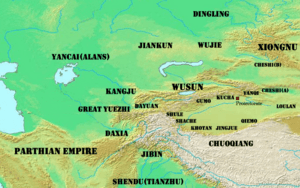Western Regions facts for kids

The Western Regions or Xiyu (Chinese: 西域; pinyin: Xīyù) is a name for Central Asia. It mainly refers to the lands west of the Yumen pass in China. Chinese people used this name from about 300 BC to 800 AD.
Sometimes, Xiyu could also mean Xinjiang or even parts of northern India. For example, the famous story Journey to the West talks about these areas.
The Xiyu region was very important because it was on the Silk Road. This was a major trade route that connected different parts of the world. It has been important for trade and travel since at least 300 BC.
Contents
History of the Western Regions
The Xiyu region saw many important events throughout history. It was a place where different cultures met and sometimes fought.
Early Conflicts and Control
A big war called the Han–Xiongnu War happened in this region. This war ended in 89 AD. Later, in the 7th century, the Tang dynasty of China sent armies to the Western Regions. This led to China controlling the area for some time.
A Hub for Exchange
The Xiyu became a key place for sharing ideas and goods. It connected East Asia (like China), the Indian subcontinent, and the Muslim world.
This connection became even stronger during the time of the Mongol Empire. Many things were exchanged, including religions. For example, Buddhism spread from India through this region to China.
Famous Travelers
A famous monk from the Tang dynasty named Xuanzang traveled through the Xiyu. He went to India to study Buddhism. When he came back to Chang'an (an old capital of China), he wrote an important book. It was called Great Tang Records on the Western Regions. This book shared many details about the lands he visited.
See also
 In Spanish: Xiyu para niños
In Spanish: Xiyu para niños

